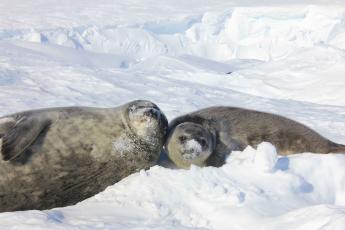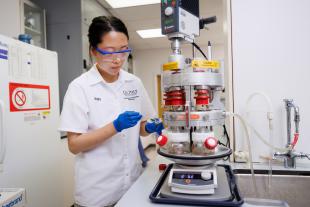Cal Poly Research Team Heading to Antarctica to Study Seal Pups

A team of Cal Poly students and professors is heading to Antarctica in October on a 10-week research expedition to study Weddell seal pups.
The team, which includes Cal Poly graduate students Emma Weitzner and Melissa Voisinet, will share their discoveries and experiences with Central Coast K-12 students via a series of Skype video conferences from McMurdo Station, the main U.S. station in Antarctica, located 850 miles from the South Pole.
They will investigate the physiology of the Weddell seal pups to learn more about the development of their ability to maintain a steady body temperature in the frigid Antarctic environment. The pups have only weeks to develop the capabilities to survive both on top of the sea ice and within the 28-degree seawater where they forage for food.
The research expedition is sponsored by a grant from the National Science Foundation for more than $1 million.
“Weddell seals have an amazing physiology that allows them to dive to deep levels and stay submerged for a long time,” said Heather Liwanag, a biology professor who’s leading the team. “The question is how do the seal pups develop, in a very short amount of time, the physiology to be able to take these deep dives and stay submerged so long.”
The researchers will also try to solve the mystery of how the young pups maintain their internal temperature in this extreme environment. The way seal pups stay warm in polar environments varies across species, and scientists don’t yet know what mechanism Weddell seals use.
The Weddell seal — the southern-most breeding mammal in the world — can dive to depths of 2,000 feet and stay under for up to 90 minutes. These seals can grow to 10 feet and weigh about 1,000 pounds, and in the wild they can live up to 30 years.
Pregnant females usually give birth to one pup in October or November — spring in the Southern Hemisphere. These young are silver or light brown (their parents are spotted gray and black) and can swim by two weeks of age.
McMurdo Station was established in December 1955 and now serves as the logistics hub of the U.S. Antarctic Program, which works to encourage international cooperation, maintain an active and influential presence in the multinational region, and continue to conduct high-quality science research.
The station includes a harbor, landing strips on sea ice and shelf ice, and a helicopter pad. The sprawling facility is built on the bare volcanic rock of Hut Point Peninsula on Ross Island, the solid ground farthest south that is accessible by ship only during the summer — December through February.
Recorded temperature extremes have been as low as minus 58 degrees and as high as 46.4 degrees. Annual mean temperature is minus 0.4 degrees; monthly mean temperatures range from 26.6 degrees in January to minus 18.4 degrees in August.




